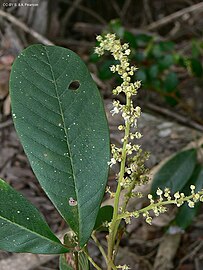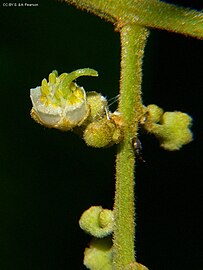| Blunt-leaved tamarind | |
|---|---|

| |
| Ripe fruit | |
| Conservation status | |
| Least Concern (NCA) | |
| Scientific classification | |
| Kingdom: | Plantae |
| Clade: | Tracheophytes |
| Clade: | Angiosperms |
| Clade: | Eudicots |
| Clade: | Rosids |
| Order: | Sapindales |
| Family: | Sapindaceae |
| Genus: | Diploglottis |
| Species: | D. obovata |
| Binomial name | |
| Diploglottis obovata S.T.Reynolds | |
Diploglottis obovata, commonly known as blunt-leaved tamarind, is a plant in the family Sapindaceae endemic to central eastern Queensland, Australia. Until 1987 it was considered to be a form of the very closely related Diploglottis diphyllostegia.
Description
The blunt-leaved tamarind is a small to medium-sized, spreading, evergreen tree growing up to 25 m (82 ft) high. It is very similar to Diploglottis diphyllostegia with branchlets, leaves and subdivisions covered in a dense light brown indumentum. The compound leaves have 2 or 3 pairs of leaflets either side of the midrib and no terminal leaflet, measuring overall about 20 cm (7.9 in) long. The leaflets are obovate to elliptic and measure up to 16 cm (6.3 in) long by 7 cm (2.8 in) wide.
The inflorescence is a panicle up to 19 cm (7.5 in) long and 10 cm (3.9 in) wide, with both staminate (functionally male) and pistillate (functionally female) flowers in the same inflorescence. Individual flowers have 5 petals with one petal usually reduced, measure about 5 mm (0.20 in) wide, and are held on a pedicel up to 3 mm (0.12 in) long.
The fruit is very similar to that of D. diphyllostegia, a 2- or 3-lobed capsule measuring up to 1.6 cm (0.63 in) long by 3 cm (1.2 in) wide with one seed per lobe, which is enveloped in an orange or red aril.
Taxonomy
The species was first described by the Australian botanist Sally T. Reynolds in 1987, and published in the journal Austrobaileya. Prior to that it had been treated as a form of Diploglottis diphyllostegia.
Etymology
The genus name Diploglottis comes from the Neo-Latin words diplo- meaning double, combined with glottis meaning tongue, and refers to the two tongue-like scales on the petals. The species epithet obovata refers to the obovate shape of the leaflets.
Distribution and habitat
The blunt-leaved tamarind is endemic to coastal and sub-coastal areas of central Queensland, from the area around Proserpine to near Bee Creek, southwest of Sarina. It grows in rainforest, most commonly on creek banks in notophyll vine forest.
Conservation
This species is listed by the Queensland Department of Environment and Science as least concern. As of 16 October 2023, it has not been assessed by the International Union for Conservation of Nature (IUCN).
Gallery
References
- ^ "Species profile—Diploglottis obovata". Queensland Department of Environment and Science. Queensland Government. 2022. Retrieved 16 October 2023.
- "Diploglottis obovata". Australian Plant Name Index (APNI). Centre for Australian National Biodiversity Research, Australian Government. Retrieved 16 October 2023.
- "Diploglottis obovata S.T.Reynolds". Plants of the World Online. Royal Botanic Gardens, Kew. 2023. Retrieved 16 October 2023.
- ^ Reynolds, S.T. (1987). "Notes on Sapindaceae, V". Austrobaileya: A Journal of Plant Systematics. 2 (4): 330. doi:10.5962/p.365711. S2CID 260275468. Retrieved 16 October 2023.
- ^ Reynolds, S.T.; Kodela, P.G. (2022). Kodela, P.G. (ed.). "Diploglottis obovata". Flora of Australia. Australian Biological Resources Study, Department of Climate Change, Energy, the Environment and Water: Canberra. Retrieved 14 October 2023.
- ^ F.A.Zich; B.P.M.Hyland; T.Whiffen; R.A.Kerrigan (2020). "Diploglottis obovata". Australian Tropical Rainforest Plants Edition 8 (RFK8). Centre for Australian National Biodiversity Research (CANBR), Australian Government. Retrieved 14 October 2023.
- ^ Cooper, Wendy; Cooper, William T. (June 2004). Fruits of the Australian Tropical Rainforest. Clifton Hill, Victoria, Australia: Nokomis Editions. p. 487. ISBN 9780958174213.
- "Search: species: Diploglottis obovata | Occurrence records". Australasian Virtual Herbarium. Australian Government. Retrieved 16 October 2023.
External links
 Data related to Diploglottis obovata at Wikispecies
Data related to Diploglottis obovata at Wikispecies Media related to Diploglottis obovata at Wikimedia Commons
Media related to Diploglottis obovata at Wikimedia Commons- View a map of historical sightings of this species at the Australasian Virtual Herbarium
- View observations of this species on iNaturalist
- View images of this species on Flickriver


